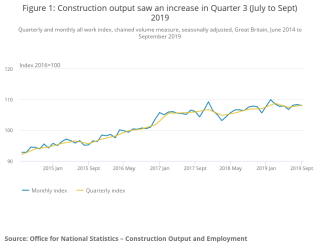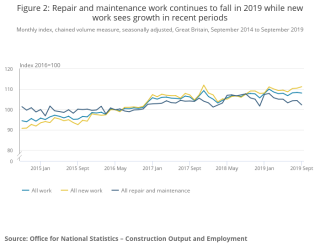The increase in output partially reversed the decrease of 1.2% seen in in Q2 (April to June).
ONS said that growth in Q3 was driven by a 1.4% rise in new work, offset slightly by a 0.8% fall in repair & maintenance.
In new work, most sectors saw an increase: private housing output was up 1.8%, private commercial was up by 1.5% and private industrial was up by 7.2%.
But while output was up for the quarter, it was down slightly in the month of September, compared to August, dropping 0.2%. Repair & maintenance was down 2.1% in September but this was partially offset by a rise in new work of 0.7%.
Construction output increased by £253m in Q3 2019 compared with Q2 2019. New work output increased by £367m. In contrast, repair & maintenance output declined by £114m, driven by a £150m fall in private housing repair & maintenance.
The ONS report excludes Northern Ireland.

Industry comment
The Federation of Master Builders (FMB) said that the latest ONS data showed that a national retrofit strategy was needed to boost the domestic repair & maintenance sector. FMB chief executive Brian Berry said: “Homeowners are holding off upgrading and improving their homes due to political and economic uncertainty. The increase in construction output seen in Quarter 3 masks the fact that the repair and maintenance sector has contracted, the bread and butter sector of the construction industry and one which keeps thousands of builders active and in work. This contraction in the private domestic sector even led to a fall in output in September, compared to the previous month. The UK has some of the oldest housing stock in Europe, that urgently needs upgrading. At a time when the government has set an ambitious target of net zero carbon by 2050, we need to be rolling out energy efficiency measures across our existing housing stock, full steam ahead. The uncertainty is holding us back.”

He concluded: “In order to boost consumer confidence, the new government must create a national retrofit strategy that sets out how to encourage home owners to upgrade England’s housing stock to the highest levels of energy efficiency. This will not only help reach the 2050 target, but will also address the scourge of fuel poverty which puts a strain on our educational institutions and the NHS. We need to urgently reverse the decline in the repair and maintenance sector which keeps so many builders active in the industry.”
Clive Docwra, managing director of construction consultant McBains, said: “These latest figures reflect the uncertainty the sector is currently experiencing. They show an increase in new work over July to September, and in particular higher than expected increases in housing, commercial and industrial new work, but a slowdown in September itself.
“We expect this slowdown to continue over the next few months, especially given last month’s confirmation of a further delay in Brexit.
“Business and investors hate uncertainty, so the continuing saga of if and when the UK leaves the EU, plus the added unpredictability of the general election, means there will be a continued reluctance to commit funding to new projects.
“We also need to see the major parties make strong policy commitments to boost the house-building programme, which is failing to deliver the number of homes required to meet the housing shortage.”
Fraser Lynes, managing director of Cruden Homes (West), said: “It’s encouraging to see a rise in output activity in the sector. Certainly at Cruden Homes we are seeing continued confidence in the housing market and as a result, we have released new phases of development months ahead of schedule, and the accelerated release of a new development, to cope with the unprecedented levels of demand. In fact the recent release of one of our Glasgow developments saw buyers queueing overnight, a level of demand we haven’t seen since 2008.”
Gareth Belsham, director of surveyors Naismiths, was even more bullish. “Construction has emerged as the economy’s ‘come back kid’. After months of flat or falling output, the sector came out swinging in the third quarter,” he said.
“While the huge size of Britain’s service sector means it must take the bulk of the credit for dragging the economy back to growth, construction deserves plaudits for pulling off the most Houdini-like turnaround. Activity is growing strongly, and the growth is refreshingly broad-based – with new infrastructure, commercial and residential building all up.
“The reversal of fortune is no overnight miracle. Brexit fears still stalk investors’ calculations, even if concerns have been soothed somewhat by the growing sense that a chaotic ‘no-deal’ exit is becoming less likely.
“Instead what we’re seeing is a gradual uncorking of some of the demand which has been repressed for months or even years. There is only so long that mothballed projects can be delayed, and while conditions are far from perfect, a steady stream of tactical investors is now sensing that opportunities can now outweigh the risks. This is no opening of the floodgates, but they are ajar – and deals are beginning to flow once again.”
Got a story? Email news@theconstructionindex.co.uk




